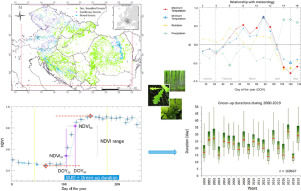当前位置:
X-MOL 学术
›
Agric. For. Meteorol.
›
论文详情
Our official English website, www.x-mol.net, welcomes your feedback! (Note: you will need to create a separate account there.)
Spring vegetation green-up dynamics in Central Europe based on 20-year long MODIS NDVI data
Agricultural and Forest Meteorology ( IF 6.2 ) Pub Date : 2020-06-01 , DOI: 10.1016/j.agrformet.2020.107969 Anikó Kern , Hrvoje Marjanović , Zoltán Barcza
Agricultural and Forest Meteorology ( IF 6.2 ) Pub Date : 2020-06-01 , DOI: 10.1016/j.agrformet.2020.107969 Anikó Kern , Hrvoje Marjanović , Zoltán Barcza

|
Abstract The present study focuses on the leaf unfolding dynamics of deciduous broadleaf forests in Central Europe. MODerate resolution Imaging Spectroradiometer (MODIS) Normalized Difference Vegetation Index (NDVI) was used to quantify green-up duration (GUD) for the wider Carpathian Basin located in Central Europe, covering the time period 2000–2019. GUD was calculated for ~170 000 pixels with deciduous broadleaf forest cover at 500 m spatial resolution. The GUD exhibited large interannual and elevation-dependent variability where the latter likely indicates the distribution of the different species. The longest mean GUD occurred in 2017 (32.7 days), while the shortest (14.5 days) was associated with 2018. The relationship between the start of leaf unfolding (SOS) and the GUD (R = -0.62) reveals that the timing of the bud break plays an important role in the leaf unfolding process. Multiple linear regression models were constructed to explain and forecast the GUD based on the date of SOS, the elevation and the meteorological variables. The main explanatory variable was the SOS date, explaining 38.3% of the GUD variability (RMSE=8 days), while the addition of the elevation and its square to the model increased the explained variance to 47.8% (RMSE=7.34 days). Further addition of meteorological variables covering periods prior to and after the SOS increased the explained variance (the best R2 was 0.65). The results indicate the complexity of processes that drive the leaf unfolding. We propose that future studies should consider SOS, elevation and meteorological variables together to interpret GUD dynamics. Earlier SOS implies longer GUD, while delayed SOS is associated with short GUD, which means that the benefits of climate change possibly realized as a longer growing season could be smaller than anticipated. Accurate estimation of the SOS is a prerequisite for the successful modeling of the GUD.
中文翻译:

基于 20 年 MODIS NDVI 数据的中欧春季植被绿化动态
摘要 本研究的重点是中欧落叶阔叶林的叶片展开动态。中等分辨率成像光谱仪 (MODIS) 归一化差异植被指数 (NDVI) 用于量化位于中欧的更广泛的喀尔巴阡盆地的绿化持续时间 (GUD),涵盖 2000 年至 2019 年的时间段。GUD 是在 500 m 空间分辨率下计算约 170 000 像素的落叶阔叶林覆盖。GUD 表现出较大的年际和海拔依赖性变异,其中后者可能表明不同物种的分布。最长的平均 GUD 发生在 2017 年(32.7 天),而最短的(14.5 天)发生在 2018 年。叶片展开开始(SOS)与 GUD 之间的关系(R = -0。62)揭示了芽断裂的时间在叶子展开过程中起着重要作用。构建多元线性回归模型,根据SOS日期、海拔和气象变量对GUD进行解释和预测。主要的解释变量是 SOS 日期,解释了 38.3% 的 GUD 变异性(RMSE=8 天),而将海拔及其平方添加到模型中将解释的方差增加到 47.8%(RMSE=7.34 天)。进一步添加涵盖 SOS 之前和之后时期的气象变量增加了解释方差(最佳 R2 为 0.65)。结果表明驱动叶子展开的过程的复杂性。我们建议未来的研究应该将 SOS、海拔和气象变量一起考虑来解释 GUD 动态。较早的 SOS 意味着较长的 GUD,而延迟的 SOS 与较短的 GUD 相关,这意味着气候变化的好处可能随着较长的生长季节而实现,可能比预期的要小。SOS 的准确估计是 GUD 成功建模的先决条件。
更新日期:2020-06-01
中文翻译:

基于 20 年 MODIS NDVI 数据的中欧春季植被绿化动态
摘要 本研究的重点是中欧落叶阔叶林的叶片展开动态。中等分辨率成像光谱仪 (MODIS) 归一化差异植被指数 (NDVI) 用于量化位于中欧的更广泛的喀尔巴阡盆地的绿化持续时间 (GUD),涵盖 2000 年至 2019 年的时间段。GUD 是在 500 m 空间分辨率下计算约 170 000 像素的落叶阔叶林覆盖。GUD 表现出较大的年际和海拔依赖性变异,其中后者可能表明不同物种的分布。最长的平均 GUD 发生在 2017 年(32.7 天),而最短的(14.5 天)发生在 2018 年。叶片展开开始(SOS)与 GUD 之间的关系(R = -0。62)揭示了芽断裂的时间在叶子展开过程中起着重要作用。构建多元线性回归模型,根据SOS日期、海拔和气象变量对GUD进行解释和预测。主要的解释变量是 SOS 日期,解释了 38.3% 的 GUD 变异性(RMSE=8 天),而将海拔及其平方添加到模型中将解释的方差增加到 47.8%(RMSE=7.34 天)。进一步添加涵盖 SOS 之前和之后时期的气象变量增加了解释方差(最佳 R2 为 0.65)。结果表明驱动叶子展开的过程的复杂性。我们建议未来的研究应该将 SOS、海拔和气象变量一起考虑来解释 GUD 动态。较早的 SOS 意味着较长的 GUD,而延迟的 SOS 与较短的 GUD 相关,这意味着气候变化的好处可能随着较长的生长季节而实现,可能比预期的要小。SOS 的准确估计是 GUD 成功建模的先决条件。



























 京公网安备 11010802027423号
京公网安备 11010802027423号